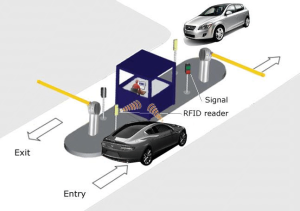
Key components and features of a Car Access Control System include:
Vehicle Identification: The system uses various methods to identify vehicles, such as RFID (Radio Frequency Identification) tags, smart cards, QR codes, license plate recognition (LPR), or biometric identifiers.
Entry and Exit Points: Access control points, typically equipped with barriers, gates, or bollards, control the entry and exit of vehicles. They can be manually operated or automated based on the access control system.
Access Control Software: Centralized software manages the entire access control system, enabling administrators to configure access rules, monitor vehicle movements, and generate reports.
Authentication: Users, such as employees, residents, or authorized visitors, are authenticated based on their credentials (RFID tags, smart cards, etc.) before they are granted access.
Integration: Access control systems can be integrated with other systems, such as security cameras, intercoms, and building management systems, to enhance overall security and monitoring capabilities.
Visitor Management: The system can facilitate visitor registration and approval processes, granting temporary access to authorized visitors.
Access Rules and Scheduling: Administrators can define access rules and schedules, determining when specific vehicles are allowed to enter or exit a location.
Alerts and Notifications: The system can generate alerts or notifications for unauthorized access attempts, anomalies, or other security-related events.
Data Logging and Reporting: Access control systems log vehicle entry and exit data, allowing administrators to generate reports for audit purposes and operational analysis.
Remote Management: Some access control systems offer remote management capabilities, allowing administrators to control access points and monitor vehicle movements from a central location.
Barrier Types: Depending on the level of security required and the type of vehicles accessing the area, different types of barriers can be used, such as boom gates, sliding gates, turnstiles, and retractable bollards.
Benefits of a Car Access Control System:
Enhanced Security: Access control systems restrict unauthorized access, preventing theft, vandalism, and other security threats.
Traffic Management: Efficient vehicle flow management helps reduce congestion and optimize parking utilization.
Convenience: Authorized users can access the area without the need for physical keys or manual intervention.
Audit Trail: Access logs and reports provide a clear record of vehicle movements for monitoring and accountability.
Visitor Management: Streamlined visitor registration and temporary access ensure smooth visitor experiences.
Integration: Integration with other security and building systems enhances overall site security and operational efficiency.
Car access control systems can be customized to meet the specific needs of different locations and industries, providing a tailored solution for effective vehicle access management.